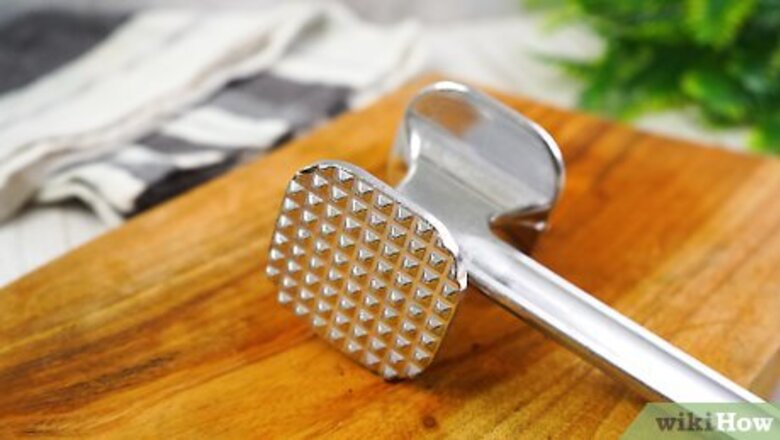
views
- Beat the meat evenly between sheets of plastic wrap with a meat mallet (or hammer in a pinch) to help the chicken cook faster.
- Marinate the chicken for at least 2 hours to add flavor and tenderize the meat.
- Pull the chicken out of the oven or pan once it has an internal temperature of 165 °F (74 °C) to ensure it stays tender and doesn’t overcook.
Using a Meat Mallet (or Hammer)

Purchase a meat tenderizing tool to pound out your chicken. Meat tenderizing tools are wooden or metal mallets with bumpy heads used to beat or pound meat to make it more tender. These kitchen tools can be found online or at most general stores. If you don’t want to purchase a meat mallet, try using a regular hammer instead. Clean the hammer off and wrap the head in a plastic bag. While this is less effective, it can work in a pinch. As another alternative, use a rolling pin to “roll out” your chicken. Pounding the meat with a mallet (or other utensil/tool) is the fastest way to tenderize chicken.
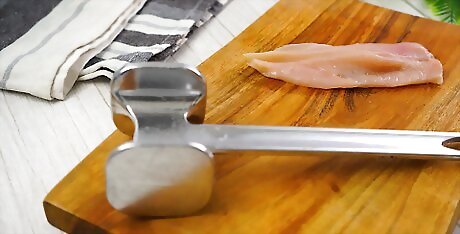
Debone your chicken or purchase boneless cuts. Only use a meat mallet on boneless cuts of meat; otherwise, you’ll get bone fragments in your meal. Grab some boneless chicken breasts or thighs from the grocery store, or debone bone-in meat yourself at home.

Cover the meat with plastic wrap. Before you start pounding the meat with your mallet, cover the entire cut with plastic wrap. This ensures that small pieces of meat won’t scatter across your countertop or workspace.
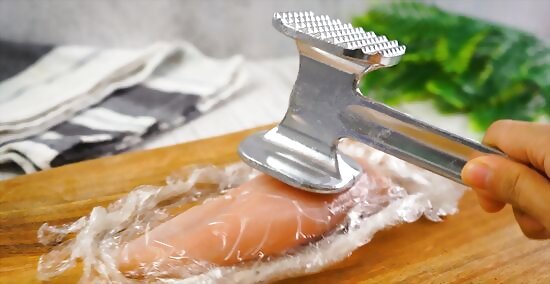
Pound the meat with the mallet until it’s the desired thickness. Use the meat tenderizing tool to hammer the meat evenly across the entire surface. Go back and forth over the meat until it's as thin as you like. Pounding breaks down fibers in the meat and allows for faster cooking. Consider marinading the chicken after pounding it to make it even more tender and flavorful.
Using a Marinade
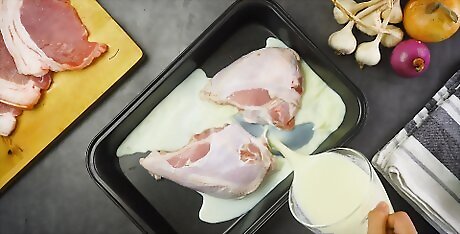
Make a plain yogurt or buttermilk marinade. Yogurt and buttermilk contain enzymes and acids that work together to break down the proteins in chicken, causing it to be more tender. That's why many cooks soak their chicken in yogurt or buttermilk overnight to get the best-tasting chicken. Here’s what you can do: For a yogurt marinade, lay the chicken in a dish and cover it with plain yogurt. Consider seasoning the yogurt with herbs and spices, like cumin or coriander, for more flavor. Try using a flavored yogurt, such as lemon, lime, or coconut, for extra flavor. Full- or low-fat yogurt works well. The chicken will have a slight yogurt flavor, which pairs well with peppers and other spices. For a buttermilk marinade, place the chicken in a dish and pour 2 c (470 ml) of buttermilk and ⁄4 c (59 ml) of vegetable oil on top, seasoning with garlic, black pepper, sea salt, and rosemary. Buttermilk is a little milder and won’t affect the flavor of the chicken as much as yogurt. If you don’t have buttermilk on hand, try making it. Simply add 1 US tbsp (15 ml) of white vinegar to a 1 c (240 ml) of milk. Let the mixture sit for 5 to 10 minutes until it curdles.
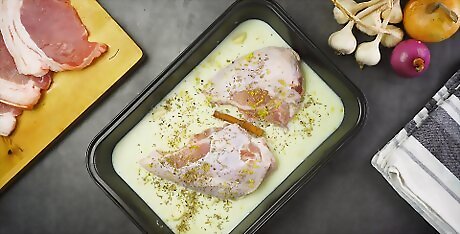
Marinate the meat for 2 hours or more. Place the meat in a container and pour enough marinade to cover it. Close the container and let it sit in the refrigerator until you're ready to use it. The longer you marinate your chicken, the more tender it’ll be. Marinating overnight is best, but marinating the chicken in buttermilk or yogurt for just 2 hours can still make a big difference in the meat’s texture. Try seasoning the marinade with spices and salt to brine the chicken while it's marinating. When you’re reading to cook, shake or rinse the marinade off the chicken.
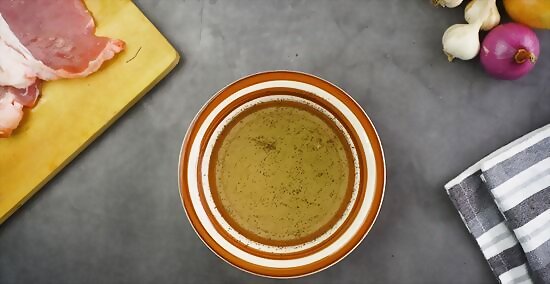
Experiment with other types of marinades. Not every marinade is the same, as each gives chicken a unique texture and flavor. From commercial to homemade marinades, there’s something for every occasion and flavor palate! Take a look at this list of common marinades to see which sounds tasty to you: Acidic marinade: Using vinegar or lemon juice in a marinade toughens meat and infuses it with a tart flavor. This type of marinade works best for curries. Enzyme-based marinade: A marinade with a pineapple or meat tenderizing base makes chicken mushy and soft, making it perfect for stews. Fruit marinade: Peeled and pureed kiwis, pineapples, and mangoes give the chicken a sweet flavor and soft texture. Soda marinade: The highly acidic properties of soda chemically break down the chicken and give it a barbecue-like flavor. Coca-Cola, Pepsi, Sprite, and Mountain Dew are surprisingly tasty when paired with poultry.
Cooking Chicken
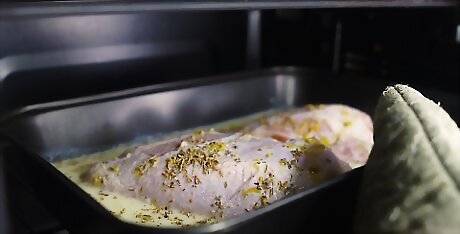
Pick a cooking method to prepare your chicken. There are many ways to cook chicken, and tenderizing the meat before you cook it can help it taste even better. Here are some of our favorite ways to cook chicken: Blackening: Put 1 US tbsp (15 ml) of olive oil in a pan on the stove. Cover your chicken with spices, then place it in the sizzling pan. Cook until the meat is no longer pink on the inside. Oven-baking: Season the chicken and place it in a greased baking pan. Bake for 30 to 40 minutes, or until no longer pink on the inside, at 350 °F (177 °C). Grilling: Transfer the tenderized, seasoned chicken to a grill and cook until it reaches an internal temperature of 165 °F (74 °C).
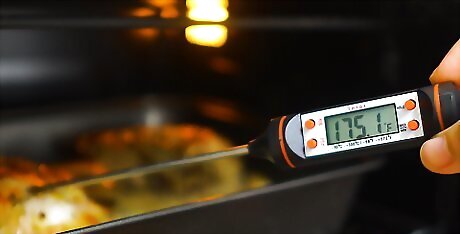
Cook chicken until it reaches an internal temperature of 165 °F (74 °C). Overcooking or undercooking your chicken can be a disaster. Overcooking causes the meat to lose moisture and get tough while undercooking can result in Salmonella or food poisoning. When cooking chicken, use a meat thermometer to check the internal temperature of the meat. The chicken is fully cooked and ready to eat if it’s 165 °F (74 °C). Place the thermometer probe in the deepest part of the meat for the most accurate results.

Try a “low and slow” cooking method for tender, juicy meat. Though seemingly contradictory to the “do not overcook” warning, low, slow cooking breaks down proteins, allowing for a more tender texture. This type of cooking also allows time for flavors and juices to penetrate the meat, making it extra juicy. Simply bake the chicken in a 300 °F (149 °C) oven for at least 1 hour. This method works best with bone-in thighs and other dark meat, or you could roast an entire chicken this way. Try cooking the chicken in a slow cooker following this method instead of using an oven.
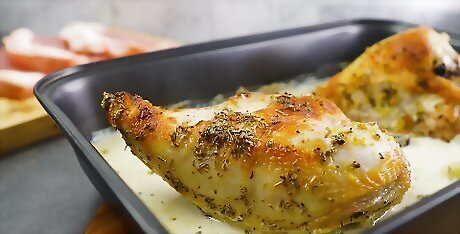
Allow the meat to rest for at least 10 minutes after cooking. Once you pull the chicken out of the oven or pan, cover it with aluminum foil and let it sit for 10 to 20 minutes. This allows the juices to redistribute in the meat. If you cut it right away, the juices are more likely to drain out, making the chicken dry.
Selecting Tender Chicken
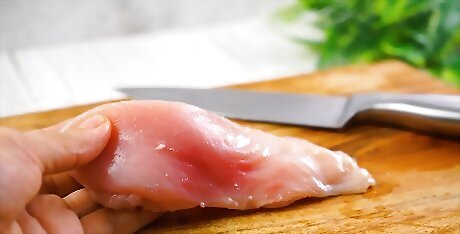
Buy your meat from a reliable, trustworthy source. It can be difficult to judge the quality of chicken just by looking at the meat. So, the best thing to do is to buy your meat from a reliable, trustworthy source. For instance, opt for a nationwide brand with FDA credentials over a store brand or visit an organic farmer over a commercial butcher.

Select darker meat for moist results. Dark meat chicken contains more fat and can be more moist and tender. Breast meat and other white meat tend to be a little tougher. However, if you use a good buttermilk marinade or a meat tenderizer, white meat can be just as soft and juicy.
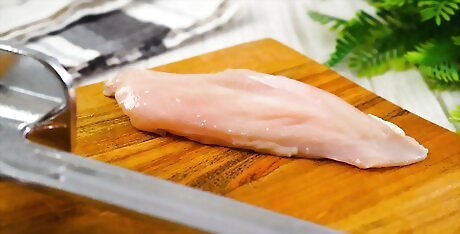
Opt to purchase younger chickens for more tender meat. Keep in mind that the older a chicken is, the tougher its meat will be. In the United States, meat chickens are processed at only a few weeks old to ensure tenderness. However, it is possible to cook older stew hens, such as those on hobby farms or backyard coops. As the term suggests, stewing the meat is the suggested cooking technique, as the older flesh tends to be tougher.




















Comments
0 comment